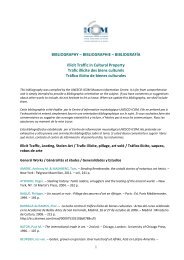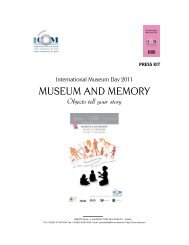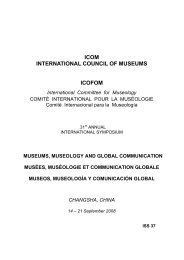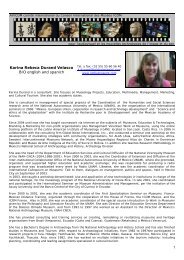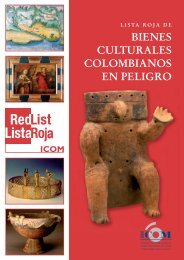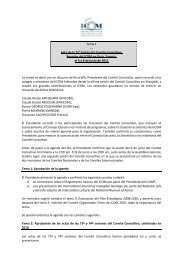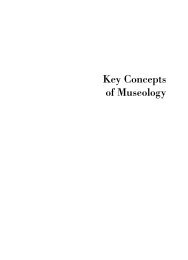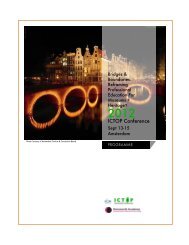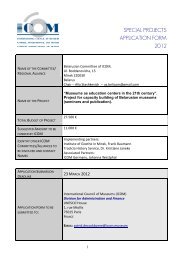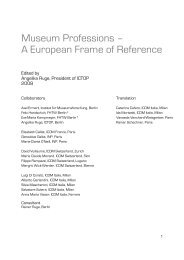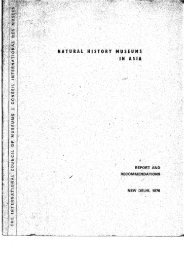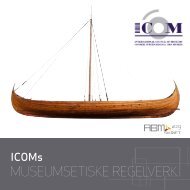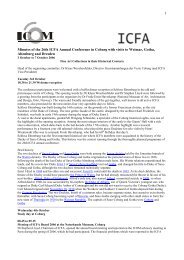ISS 25 (1995).pdf - The International Council of Museums
ISS 25 (1995).pdf - The International Council of Museums
ISS 25 (1995).pdf - The International Council of Museums
Create successful ePaper yourself
Turn your PDF publications into a flip-book with our unique Google optimized e-Paper software.
and the curator has the role as a skilled adviser and a member <strong>of</strong> the world<br />
outside the museum building.<br />
Let us see what happened in Odda, when we went from an idea to hard work.<br />
As an ethnologist 1 work with a holistic view <strong>of</strong> the society. I wanted to collect<br />
and show all parts <strong>of</strong> an environment and interview different groups in the<br />
local society. 1 wanted to let people tell the story <strong>of</strong> their life, their home,<br />
work and leisure time, to document their feelings, thoughts and dreams.<br />
1 was the only person employed and it was necessary to engage voluntary aid,<br />
for example skilled workers, house wives and children so that they could tell<br />
about their lives and show me what we could use in exhibitions.<br />
Our first museum building was a workman's dwelling with 1 room and a<br />
kitchen per family, and 4 families in each house. We saved this building from<br />
being demolished, and we started to collect furniture, clothes and photos.<br />
Many people came to see what they could give to create an original interior.<br />
Gradually we were able to tell the stories <strong>of</strong> real families in different time<br />
periods, one in the 1920' s, one in the 1930' , one in the 1950' s etc. We told the<br />
story <strong>of</strong> Mr. Ingebrigtsen, who worked at the factory as a blacksmith. He<br />
moved from the town <strong>of</strong> Bergen to Odda with his family, a wife and two<br />
children (two already died from disease), and two to be born in the flat that he<br />
was lucky to let from the factory (with electricity and everything). <strong>The</strong>y<br />
moved to Odda because the wages were much higher here. We also told what<br />
happened to the family when the factories owned by the British Sun Gas Co.<br />
went bankrupt and 1000 men were on the dole for four years in the 1920' s<br />
before the factory was refinanced. We described the work <strong>of</strong> a mother, and<br />
how she had to make everything herself, and work as a cleaner at the school<br />
nearby. We described happiness and sorrow in the family, e.g. how difficult it<br />
was when the 14 year old son died and his class came to take farewell, and<br />
when his brother Willy earned his first money to buy a suit for the<br />
confirmation day, and later when he saved money to buy a radio (1938) in<br />
order to get the news from the Civil War in Spain.<br />
At first everyone said: "I have nothing interesting to tell you", but fortunately<br />
some <strong>of</strong> them told their story anyway. Finally they were proud <strong>of</strong> what they<br />
managed to tell, down to the tiny little detail and at first sight unimportant<br />
incident. We collected different life stories in a book illustrated with photos<br />
from their own private album. <strong>The</strong> readers really got to know little Willy as a<br />
boy in the 1920' s, and Alice told us how she, as the daughter <strong>of</strong> a managing<br />
director, grew up. It was all so close, and it was possible to recognize things,<br />
to see the connection between the groups in the local society at a time when the<br />
industry was young.<br />
<strong>The</strong> interviews went on and suddenly we had 200 story tellers and friends <strong>of</strong><br />
197



